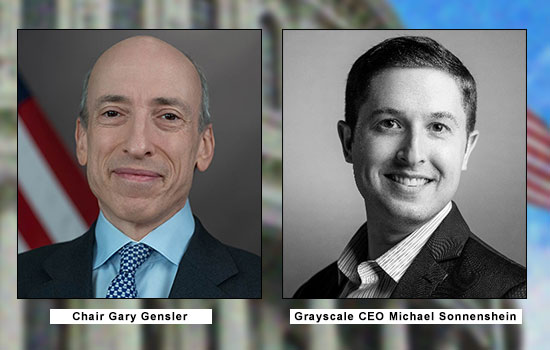Late yesterday, the Securities and Exchange Commission (SEC) announced its rejection of applications by both Grayscale (see entire PDF) and Bitwise (view that one) to create first-of-its-kind Bitcoin Spot ETF (Exchange-Traded Fund) investment vehicles.
In declining the Grayscale application, which would have converted the Grayscale Bitcoin Trust (GBTC) to an ETF, the SEC said the company did not show it could overcome the Commission’s concerns around the potential for fraud and market manipulation:
“Because, here, NYSE Arca is seeking to list a spot bitcoin ETP (i.e. Grayscale’s spot Bitcoin ETF) that relies on the CME as the purported ‘significant’ regulated market with which it has a comprehensive surveillance sharing agreement, the assets held by the proposed ETP would not be traded on the CME. Thus there is reason to question whether a surveillance-sharing agreement with the CME would, in fact, assist in detecting and deterring fraudulent and manipulative misconduct affecting the price of the spot bitcoin held by the proposed ETP. The Exchange could have overcome this concern by demonstrating that there is a reasonable likelihood that a person attempting to manipulate the proposed ETP would have to trade on the CME in order to manipulate the ETP because such demonstration would help establish that the Exchange’s surveillance-sharing agreement with the CME would have the intended effect of aiding in the detection and deterrence of fraudulent and manipulative misconduct related to the spot bitcoin held by the proposed ETP. As discussed and explained above, the Commission finds that NYSE Arca has not made such demonstration.”
For Bitwise and its ETP Trust, the SEC rejected its application on similar terms:
“NYSE Arca has not provided sufficient information to establish both prongs of the ‘market of significant size’ determination, and thus the Commission cannot conclude that the CME bitcoin futures market is a ‘market of significant size’ related to spot bitcoin such that NYSE Arca would be able to rely on a surveillance-sharing agreement with the CME to provide sufficient protection against fraudulent and manipulative acts and practices. Therefore, NYSE Arca has not met its burden of demonstrating that the proposal is consistent with Exchange Act Section 6(b)(5),135 and, accordingly, the Commission must disapprove the proposal.”
What’s next
In short, a lawsuit.
Although Bitwise has yet to comment, a statement released last night by Grayscale announced its intention to sue the SEC. Grayscale CEO Michael Sonnenshein added, “… We are deeply disappointed by and vehemently disagree with the SEC’s decision to continue to deny spot Bitcoin ETFs from coming to the U.S. market.”
Grayscale Chief Legal Officer Craig Salm subsequently tweeted a screenshot of the filed lawsuit.
The company and its CEO have been anticipating the lawsuit long before the latest rejection with consistent saber-rattling to the effect that any disapproval by the SEC would be a violation of the Administrative Procedures Act.
-
- Last December, the company sent a letter to the SEC through its lawyers saying that the approval of recent Bitcoin futures ETFs should mean that Bitcoin spot ETFs get approvals, too – otherwise, a lawsuit is likely.
- On June 7, the company tweeted a thread saying that in addition to its securities law firm Davis Polk & Wardwell, “…We have retained Donald B. Verrilli, Jr., former Solicitor General of the United States, as additional legal counsel.” The hiring of Verrilli, who worked in the Obama Administration from 2011-2016, would appear to amp up the pressure on Biden-appointed Chair Gary Gensler. Verrilli’s name is on the screenshot of the lawsuit filed last night.
- And on June 14, Grayscale CEO Michael Sonneshein reiterated the litigation threat by saying as much at a Grayscale-sponsored Axios event .
The process to-date
Grayscale began its latest odyssey with its application filing to the SEC around 240 days ago on November 2, 2021 (PDF). Bitwise’s process began just a few days prior to Grayscale’s on October 28 (PDF).
Since November, Grayscale has presented an array of touchpoints for the SEC as well as public market participants.
On Monday, Grayscale CEO Michael Sonnenshein outlined on the company blog the 240-day review process – known as the 19b-4 filing process – through which his company tried to convert Grayscale Bitcoin Trust (GBTC) into an ETF including:
-
- Microsite: A microsite to educate on why the need for the GBTC to ETF conversion.
- Public comment: This microsite site includes an ability to comment on the company’s application with the SEC, which received 11,400 comments as of June 9, 2022 according to Grayscale with 99% positive on the application. Visit the comment ledger on the SEC website.
- Media relations: Among many industry events it has sponsored, Grayscale supported three notable DC events in the last few months including one with Politico, Axios and The Washington Post. The Politico and WaPo events piggy-backed on the Lummis-Gillibrand RFIA bill roll out.
There were three key meetings listed on the SEC website over the course of Grayscale’s latest application including:
-
- April 12: In-person SEC meeting with Coinbase (see PDF) – Included 11 members of the SEC across the Division of Trading and Markets (4 members) and Division of Economic and Risk Analysis (7) as well as 5 members of Coinbase presumably to discuss its views on Bitcoin markets today.
- April 14: SEC’s Hester Peirce videoconferences with Coinbase (PDF) – Commissioner Peirce has been a supporter of the blockchain industry in general, and has said to the industry – most recently at the Digital Chamber event in DC in May – that it should keep her informed as companies pass through the SEC.
- April 26: SEC meets with representatives of Grayscale Bitcoin Trust (PDF) – According to the SEC report, the Grayscale team and its lawyers (11 people total) led by CEO Sonnenshein presented to 13 members of the SEC split between the Division of Trading and Markets (2) and Division of Economic and Risk Analysis (11).
The six key areas for the SEC according to Grayscale’s presentation to the Commission on April 26 were as follows:
-
- Potential for fraud and manipulation in underlying Bitcoin markets – Grayscale offered proof from comments (1 – PDF)
- Coindesk XBX Index mitigating the impact of instances of fraud and manipulation on a reference price for Bitcoin – proof (1, 2)
- Coindesk XBX Index design to protect investors and the public interest, consistent with applicable requirements of Section 6(b)(5) of the Act – proof (1, 2)
- Lead/lag analysis comparing CME Bitcoin futures to spot Bitcoin markets – proof (3, 4)
- CME Bitcoin futures market as a regulated market of significant size – proof (1, 3, 4, 5)
- ETFs registered under the ‘40 Act versus the ‘33 Act – proof (6, 7, 8)
In the lead-up to yesterday’s announcement, Grayscale had already lined up market makers Virtu Financial and Jane Street which would have led the charge in the public markets. On Monday, Grayscale CEO Michael Sonnenshein had added in a tweet that BNY Mellon and Ernst & Young were among “a coalition of institutions” who would support the ETF.
The institutional and public support appears to be there. But the last pillar of support from the SEC is not. Bloomberg Intelligence is projecting that Grayscale’s lawsuit against the SEC may take until to 2024 to wind its way through the court. So, maybe, a Bitcoin Spot ETF in the U.S. thereafter? Bloomberg’s BI team thinks Grayscale will lose. A new administration and new SEC Chair in 2025 may be what ultimately pushes the Spot Bitcoin ETF over the goal line.
Read more:
-
- Bitcoin spot vs. futures ETFs: Key differences explained – Coin Telegraph

